Site menu:
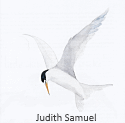
June 2019 Newsletter
Gronant Little Terns.
Waders Heading Off.
May Bird News.
Forthcoming Events.
Latest Newsletter.
Gronant Little Terns
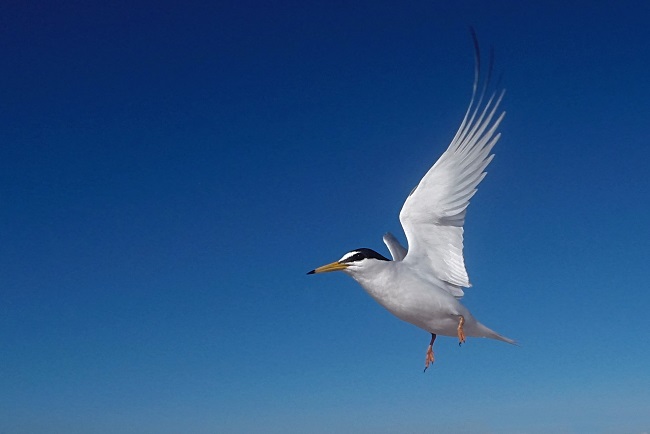
As I write this at the end of May the 2019 breeding season is already
well underway at Gronant with the first Little Tern eggs already laid.
Gronant really is a great place to visit this time of year and as well
as the 150 or so pairs of Little Terns there will also be breeding
Ringed Plovers and Oystercatchers in the sand dunes as well as
Grasshopper, Reed and Sedge Warblers in the nearby reed bed with many
other species to be seen in the sand dunes and on the beach.
There's always a chance of a rarity and in 2018 they had an American
Golden Plover, Cetti's Warbler, Bee-eater and Great Egret. Out at sea
there will be Gannets, Common Scoters and, given a brisk westerly, Manx
Shearwaters.
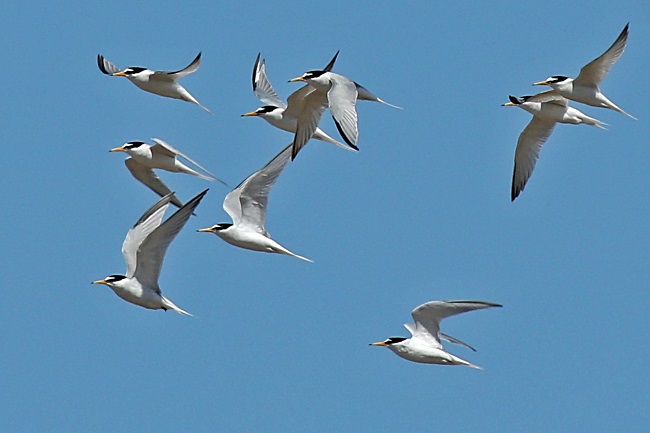
Wanted - Voluntary Wardens
The Little Tern Colony, the only one in Wales and one of the most productive in the British Isles, wouldn't exist without the wardening scheme which has been in place since 1975. I was a warden at Gronant for around 15 years and it's a great experience. If you want to have a go either contact the North Wales Little Tern Group (http://www.deeestuary.co.uk/news0618.htm), Denbighshire Countryside Services or just turn up at Gronant and introduce yourself.
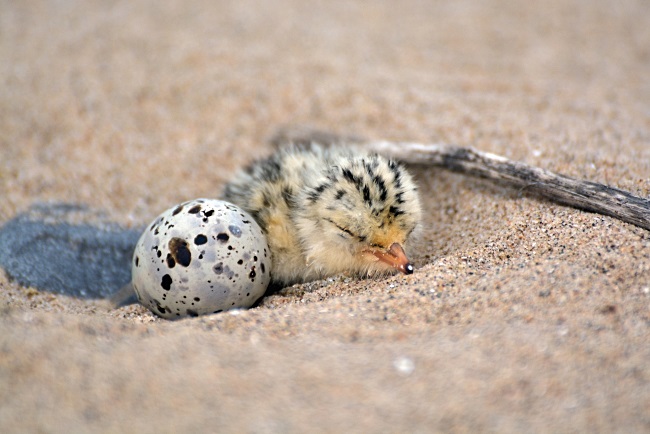
Review of 2018 Season
If you'd been at Gronant on June 14th when Storm Hector struck you'd be justified in thinking that most of the colony had been destroyed and that it would be a disastrous breeding season. It was certainly unlucky that this unseasonable storm coincided with the highest tide of the month causing a significant storm surge. 89 nests were washed away but thanks to the wardens many were saved by physically moving the nests up the beach.
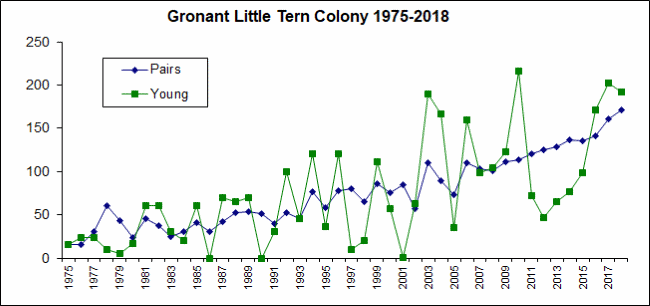
Amazingly the season turned out to be yet another record breaking one with 171 pairs, up from the previous year's high of 161 pairs. About 80 nests survived the storm with the rest successfully re-laying which resulted in 192 fledged young, the third highest ever recorded at Gronant. Quite a lot of the newly hatched chicks were predated at night by foxes, badgers and weasels so if we can reduce this there is potential for a much higher number of fledglings and we hope that in 2019 we can beat the record of 216 set in 2010.
Little Tern Colour-ringing
Thanks partly to funding by the LIFE+ Little Tern
Species Recovery Project over the past five years there has been a big
effort to colour ring birds in order to gain data on their movements
and survival. In 2018 51 adults and 109 chicks were colour-ringed at
Gronant. Other sites also ringed birds and that told us that after
Storm Hector struck many of the Isle of Man colony at the Point of Ayre
upped sticks and moved to Gronant, which at least partly explains how
again there was an increase in breeding birds here.
Just 110 miles west of Gronant is a similarly sized Little Tern Colony
at Kilcoole, south of Dublin, and there appears to be much interchange
between the two sites with 26 birds ringed at Kilcoole recorded at
Gronant in 2018. It may well be that Kilcoole, Isle of Man, Gronant and
other Irish Sea colonies act as one meta-population with birds moving
between the colonies not only from season to season but within the
breeding season. In fact Gronant is not only a sizable breeding colony
it also appears to be a major migration staging post as we always get
an increase in numbers around the third week in July as the breeding
season comes to an end and in 2018 we had a peak of 620 adults on July
18th due to an influx from other sites. This just shows how important
the sea off Gronant is as a feeding area for this species.
The table below is taken from the Little Tern Report 2018.

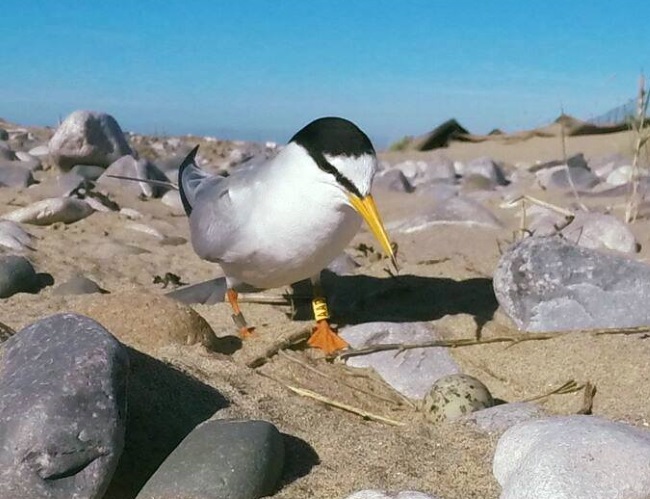
LATEST from Gronant May 2019
Extract from North Wales Little Tern Blog (https://northwaleslittleterns.weebly.com/blog)
by Henry Cook:
The update from today's (29/05) clutch count was that there are now 148
nests and 393 eggs. We are nearly at the peak and it is only eight days
since the first nest was found. The average clutch size is also looking
healthy at 2.67, the second highest on record! With this many nests to
care for if you feel like spending a few hours down at the colony
please come down and help keep watch over this ever-growing population.
Now's a great time to see them with constant bird activity around the
beach.
References and Further Reading
1. Henry Cook, Marie Dipple, Frances MacCormack & Sasha Taylor, Gronant Little Tern Report 2018, Denbighshire County Council Countryside Service.
2. North Wales Little Tern Group - https://en-gb.facebook.com/nwlittletern/,
email: nwlittletern@gmail.com.
3. Gronant Site Guide: http://www.deeestuary.co.uk/news0609.htm
4. Kilcoole Little Tern Conservation Project - littleternconservation.blogspot.co.uk.
Top of PageWaders Heading Off
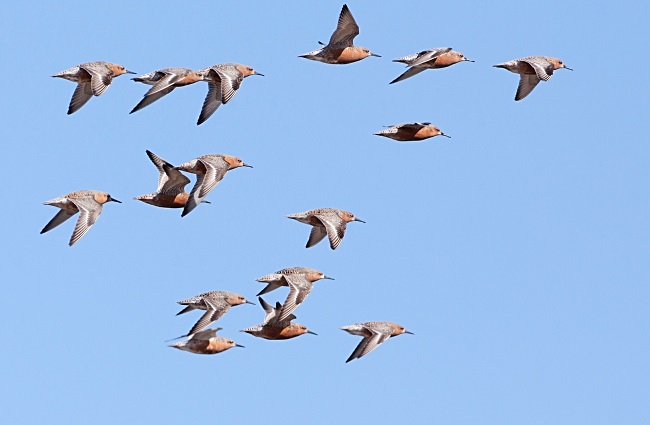
one of two major staging posts, the other being Iceland.
If you hear waders calling loudly out on the beach
in spring, you may be about to witness some depart on their migration
towards their breeding grounds. Loud calling is a part of pre-migratory
restlessness. Sometimes a group of waders will fly up calling but then
return to the beach. If the birds are really departing some birds take
off, others may join the group and the noisy group then adopts a
distinctive departure flight. With rapidly beating wings they head
upward and away usually in a direct line. If you can get onto the group
through a telescope they will maintain a roughly constant heading until
lost to view. The flocks are often small, around ten birds but can be
up to hundreds, and as they get underway the bunch often spreads into a
line. Once lost from view it is time to get out your compass and using
the telescope as a pointer, record the bearing they took and for good
measure also the time, cloud cover, and wind direction and speed. A
look at a map will then show where the flock was heading. If you use a
compass app on a smartphone, make sure it is working correctly
beforehand!
During late April 2019 we saw Black-tailed Godwits head off from RSPB
Marshside and Red Knot head off from Southport beach, both on
north-westerly bearings of 335° and 322° respectively that would take
them to Iceland (see map below for bearings the Knot took, North is the
top of each map). For the Godwits that will be journey’s end, but for
the Knot Iceland is a staging post before their onward migration at the
end of May to Greenland and over the Greenland ice cap to the high
arctic islands of Canada. They spend their time in Iceland fattening up
on molluscs at low tide, and in recent years have taken to raiding
germinating barley from coastal fields, mostly at high tide. They also
complete their moult into breeding plumage. That the Knot were indeed
departing to Iceland is supported by a recent report of a Knot
colour-ringed at Altcar Training Camp being read in the Southwest of
Iceland on April 29th.
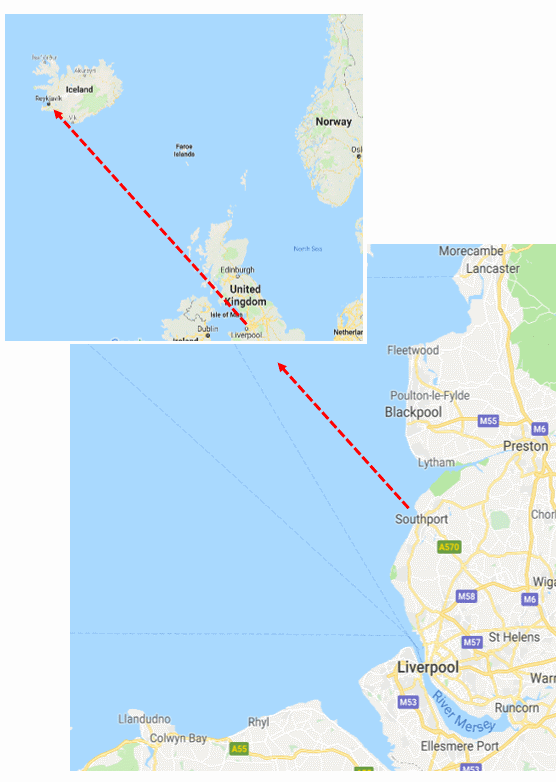
Earlier in the spring, in March and early April we also witness departures from the Sefton coast, but in a very different direction. At that time Bar-tailed Godwits are leaving and being very noisy about it. They sometimes circle over the beach before heading off, sometimes accompanied by other species such as Grey Plover, but when they go it is to the east, heading high inland. This shows that they are crossing England to North Sea sites such as the Wash and the Dutch and German Wadden Sea before returning to breeding grounds. We see Knot depart at that time too and on the same bearing. These are thus most likely to be Knot that undertake their post-breeding moult on North Sea shores, then fly west to spend winter on the Irish Sea coasts.
What conditions are best to observe waders depart? There is currently no well-founded answer to this question. Knot leaving Vlieland in the Netherlands in early May were logged between 1964 and 1967 (Swennen 1992). Swennen found that the Knot departed only in the evenings, but we have seen wader departures from the Sefton coast from mid-morning onwards. He also found that Knot always left after roosting and suggested this allowed digestion of their last meal so that they were carrying least excess weight on departure. We too have seen this, but birds will also fly up from where waders are feeding to join departing groups. Because waders are making a long flight, the weather they encounter en route and at their destination may be very different from those at departure. Perhaps for this reason, local weather may have little influence on departure, and Swennen recorded birds flying off into wind so strong that their progress was slow. But there is little published information on wader departures - what is needed is more observations on more wader species to test current ideas.
Not all waders leave us in spring. For the larger species such as Knot, Bar-tailed Godwit and Grey Plover, birds born the previous year stay behind, still in their dull non-breeding plumage. Liverpool Bay is an important summering site for these ‘gap-year’ birds including the Dee estuary, and following a successful breeding year a flock of several thousand grey Knot can be seen throughout June and July. These are then joined by returning adults from the end of July onwards, their arrival being obvious as they are still in breeding plumage.
Reference:
Swennen, C 1992 Observations on the departure of Knots from the Dutch
Wadden Sea in spring. Wader Study Group Bulletin 64 Supplement, 87-90.
Peter Knight and Rose Maciewicz
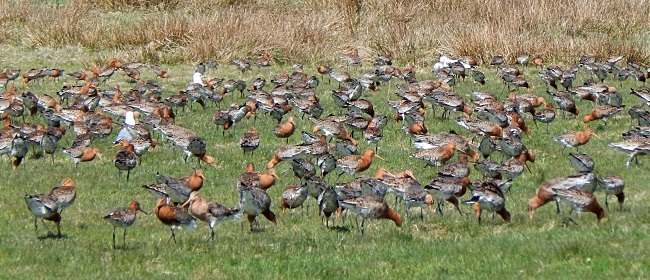 Editor:
Peter and Rose's map above shows the direction Knot take when leaving
Southport, taking them directly to south-west Iceland which
colour-ringing has shown to be a major staging post for this Irish Sea
population. The slightly different heading of 335° taken by Black-tailed
Godwits would take them straight to Álftafjörður, an extensive area of
mud-flats in south-east Iceland well known as a staging post for this
species prior to the dispersal around the island to breed. Totally
remarkable that the birds can take such an accurate heading from over
950 miles away to their destination, and that Pete and Rose managed to
accurately measure it. You will note that the route of both takes them
over the Hebrides and if they meet head winds at that point they often
touch down here until a change of wind direction. This happened in
April 2017, the photo shows a large flock of Black-tailed Godwits on
Tiree on April 25th that year (photo by John Bowler). This year,
2019, a colour-ringed Red Knot (with flag H7) was recorded on South
Uist on May 7th (previously photographed by me at Caldy, below).
Richard Smith.
Editor:
Peter and Rose's map above shows the direction Knot take when leaving
Southport, taking them directly to south-west Iceland which
colour-ringing has shown to be a major staging post for this Irish Sea
population. The slightly different heading of 335° taken by Black-tailed
Godwits would take them straight to Álftafjörður, an extensive area of
mud-flats in south-east Iceland well known as a staging post for this
species prior to the dispersal around the island to breed. Totally
remarkable that the birds can take such an accurate heading from over
950 miles away to their destination, and that Pete and Rose managed to
accurately measure it. You will note that the route of both takes them
over the Hebrides and if they meet head winds at that point they often
touch down here until a change of wind direction. This happened in
April 2017, the photo shows a large flock of Black-tailed Godwits on
Tiree on April 25th that year (photo by John Bowler). This year,
2019, a colour-ringed Red Knot (with flag H7) was recorded on South
Uist on May 7th (previously photographed by me at Caldy, below).
Richard Smith.
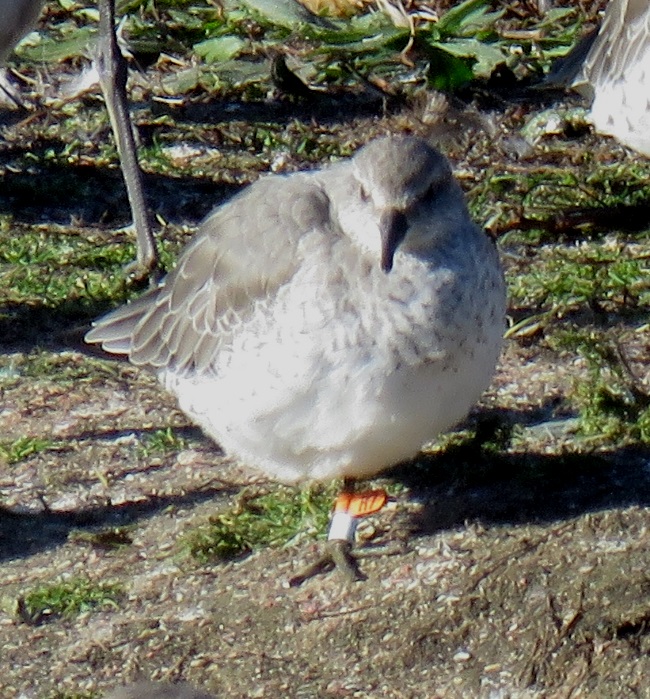
May Bird News
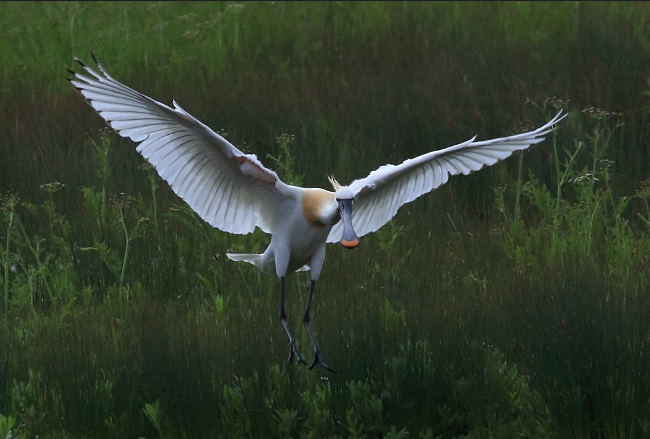
The focus in April was very much on the Leasowe Lighthouse area with a
great showing of Yellow Wagtails and their relatives, Ring Ouzels and
Redstarts, but May has definitely been all about Burton Mere Wetlands.
For starters there has been the breeding activity of no less than FIVE
heron species and I let Graham Jones (RSPB Dee Estuary site Manager)
take up the story:
It is absolutely staggering to see five different heron species making their home here. The grey herons nest here each year, but little egrets only colonised the UK in the late 1980s and have only been breeding here since 2005. For them to now be joined by the much rarer cattle egrets, great white egrets and spoonbills is even more astonishing. They’re usually more at home breeding in the Mediterranean, so we’ve been dubbed the ‘Costa del Dee’ by some of our visitors. If the birds all breed it will be extraordinary and cause for additional celebration in our anniversary year. (Extract from the BMW Blog Post for 23/05/2019).
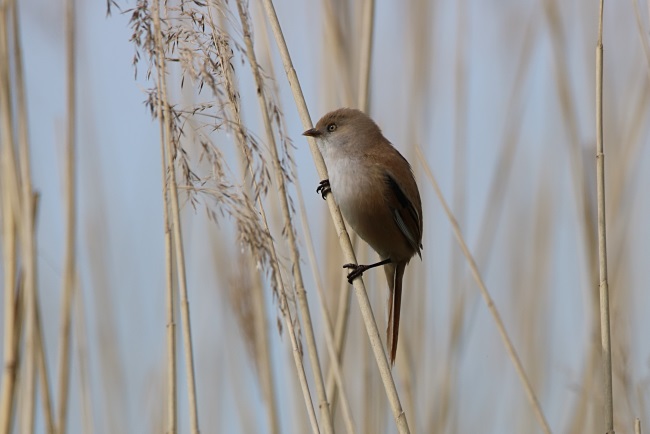
On top of that the Bearded Tits, a first for the
reserve just a few months ago, have successfully bred and some visitors
have been lucky enough to see the young, and the adults have already
started a new nest for a second brood. A remarkable nine pairs of
Mediterranean Gulls are nesting, it was only in 2017 that they first
bred successfully here after several years of trying, and that was just
one pair. Last year's wader breeding bonanza seems to be being repeated
with big numbers of Lapwing, Redshank and Avocet nests, and plenty of
chicks already hatched. A White-winged black Tern was recorded on the
24th and 25th, the Dee estuary's 11th record, the last one also being
at BMW in June 2016. Other highlights were three drake Garganeys, two
Curlew Sandpipers including one in breeding plumage plus several other
passage waders such as Wood Sandpiper and Little Stint and at least one
Black Tern present for several days.
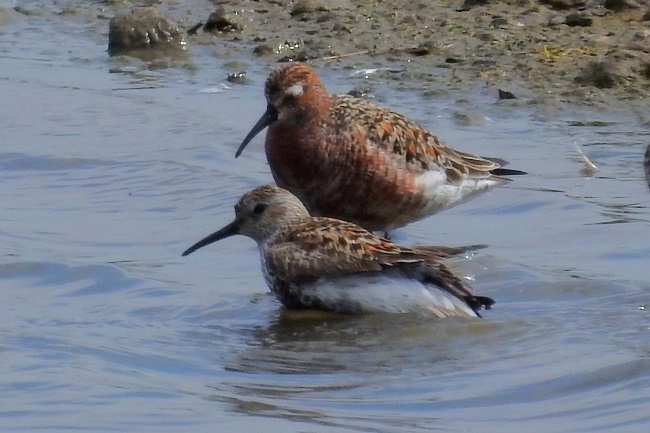
Elsewhere, Whimbrels came through in good numbers at Heswall with seven counts of over 50, max 87 on the 7th. 2,750 Ringed Plovers at Hilbre on the 27th is, we think, the highest count of this species on the Dee estuary since the 1970s and exceptionally high for May as most years numbers peak in August (see Species Spotlight - Ringed Plover). These will be birds which have wintered in Africa on their way to the far north to breed.
Nearly all Ring Ouzels pass through here in late
March and April (see Ring Ouzels in Spring)
so it was a surprise when a female turned up on the 17th and stayed
several days. Seems likely this was a failed local breeder.
There were five records of Hobbies but only two Ospreys plus several
sightings of both Hen and Marsh Harriers. A species which always
migrates through in May is the Spotted Flycatcher and we had 17 records
this year, nearly all in the Leasowe Lighthouse area, another late
migrant is the Whinchat and these peaked on the 10th with 13, also by
Leasowe Lighthouse. Rarities included a Hooded Crow, Glossy Ibis,
Glaucous Gull and Siberian Chiffchaff, a Hoopoe flew over Ness Gardens
on the 16th but report didn't get out until nearly two weeks later.
See also 'latest from Gronant' in the above Little Tern article - good
news!
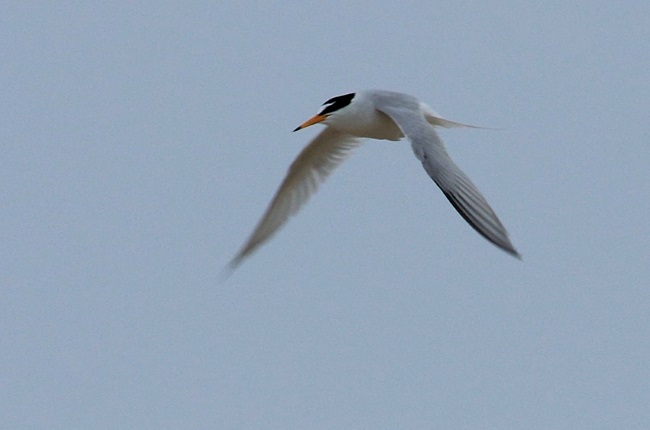
Many thanks go to Mark Gibson, Eddie Williams, Carole Killikelly, Geoff Robinson, David Haigh, Mark Woodhead, Steve Hinde, Matt Thomas, Chris Butterworth, Bruce Atherton, David Leeming, Alan Hitchmough, Paul Mason, Steve Williams, Derek Bates, Allan Conlin, Karen Leeming, Roy Lowry, Colin Schofield, Dave Edwards, Richard Whitby, Linda Platt, Steve Hart, Julie Rogers, Charles Farnell, David Roe, Graham Connolly, Les Hall, Chris Wilding, David Small, John Johnson, Nicholas Montieth, Steve Hasell, Katie Barrett, John Harland, Ian Goldstraw, George Knight, Karol Boyd, Alison MacKinnon, Anthony Molloy, Graham Thompson, Neil Simpson, Paul Ainscough, the Lighthouse and Wirral Birding Blog, the Dee Estuary Wardens and the Hilbre Bird Observatory for their sightings during May. All sightings are gratefully received.
Top of Page
What to expect in June
For the sake of the Little Terns lets hope we don't get any gales this month but any fresh westerly wind should bring in Gannets and Manx Shearwaters along the Liverpool Bay coast, and we often see hundreds of Common Terns along north Wirral from their colony at Seaforth perhaps accompanied by one or two skuas. The end of June should see a build up of gulls on the estuary, look out for Mediterranean Gulls in full summer plumage, with several pairs breeding at Burton this year it will be interesting to see if that results in more sightings out on the estuary and north Wirral, particularly juveniles. Among the gulls we will see Sandwich Terns starting to build up, another species which has an early breeding season.
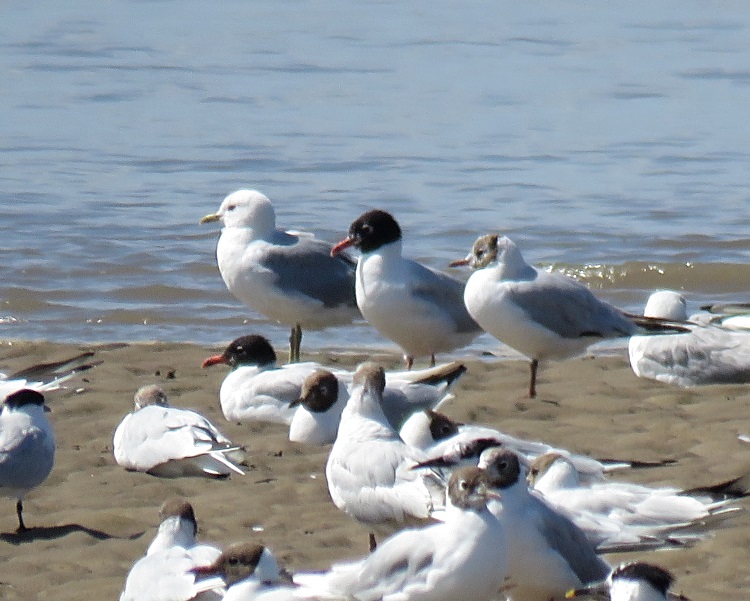
Forthcoming Events
June Highest Spring Tides (Liverpool)
Also see Tides page.
4th June, 11.51hrs (BST), 9.2m.
5th June, 12.32hrs (BST), 9.2m.
6th June, 13.14hrs (BST), 9.2m.
Forthcoming Events
Organised by the Wirral Ranger Service , Flintshire Countryside Service and the RSPB (Dee Estuary): All these events and walks have bird interest, even those not advertised specifically for birdwatching. No need to book for these events unless specified - please check below.